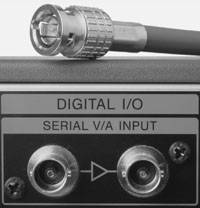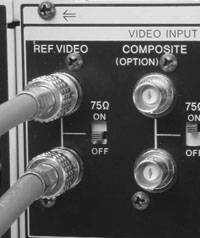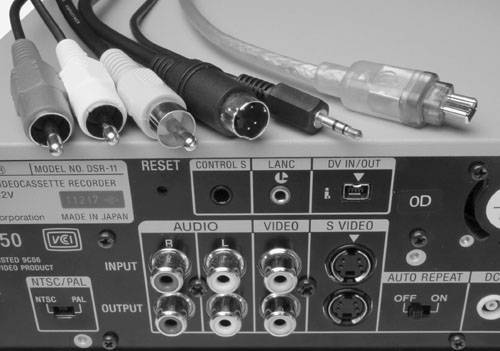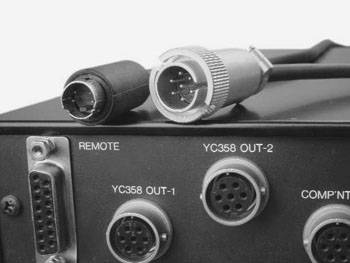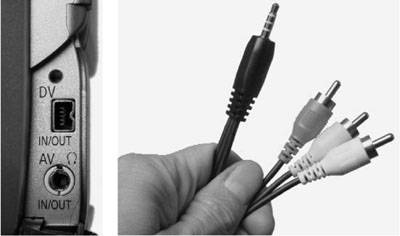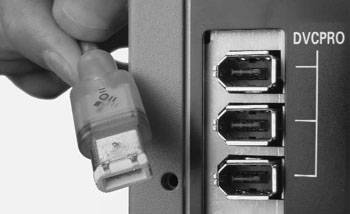Video Interfaces
| Connecting up video gear isn't difficult, but it's not entirely simple, either. You can choose among several kinds of video signals, and they vary in the quality they deliver. To keep things more interesting, different signal types often use the same kind of connector, so you can't just plug a cable into any physically compatible jack and expect things to work. Fortunately, you can master the complications with just a little effort. Analog I/OAnalog video interfaces fall into three classes: component, Y/C, and composite. You'll find analog component on both standard-definition and HDTV equipment, though these days HD analog is usually reserved for monitoring purposes, not transfer into and out of FCP. Y/C and composite signals are only found on SDTV gear, or as SDTV outputs on HDTV gear.
ComponentComponent connections provide the cleanest, highest-resolution signal possible, and you should use them whenever possible. Three separate cables carry component video, one each for the luma signal and the two color-difference signals (although some interfaces, mostly on graphics equipment, monitors, and projectors, may offer an RGB component option). The normal nomenclature for this connection is YPRPB, though you'll sometimes see Y, R-Y, B-Y, or YUV labels. The sync signal is part of the Y signal in almost all cases. Sync is normally carried on the Green channel in RGB, but sometimes you'll see a separate sync connection (which takes a combined vertical and horizontal sync) or separate horizontal and vertical syncs (mostly on computer graphics equipment). Y/CY/C, also called S-Video (and sometimes mistakenly called S-VHS), is the next best thing to component, and it preserves most of component's quality. Two separate signals in one multicore cable provide Y/C connections. The luma is separate from the chroma, but the color-difference signals have been subcarrier-modulated into a composite color signal. Although this modulation reduces the quality of the color somewhat, having separate luma and chroma preserves all the resolution the luma signal is capable of and prevents the cross-luma and cross-color artifacts of a composite signal connection. Sync is carried in the Y signal. CompositeThe lowest common denominator is composite: luma and chroma have been mixed together, just as in an analog television broadcast, and they suffer for it. Cross-color and cross-luma artifacts are likely to occur, and the resolution of both luma and chroma are compromised by the processing needed to extract them from a composite signal. You'll find composite signals on almost every bit of video equipment. The connectors may be labeled video, comp., composite, or VBS, the latter standing for video, [color]burst, and sync. There is a fourth analog connection: the radio-frequency modulated signal on the RF or ANT (antenna) connector. This carries a composite signal modulated on a carrier for transmission, and needs to be demodulated from whatever TV channel the signal is on to a baseband video signal, using the tuner in a VCR or a stand-alone demodulator. Unless you're working with live signals off-air or out of a cable or satellite box, you shouldn't ever have to deal with an RF signal as a video source. Digital I/ODigital connections fall into the general classifications of SDI, SDTI, and FireWire.
SDIThe Serial Digital Interface is the most common digital video connection in production and postproduction. It's described in SMPTE standard 259M, and you'll often see that number used to specify the connection. Curiously enough, SMPTE 259M describes both the 10-bit 4:2:2 digital component connection we all know and love, and the 4fsc digital composite connection briefly used at the dawn of the digital age but now mostly extinct from the postproduction world. Serial digital component video conforms to the ITU-R BT.601 specification, as discussed in Lesson 7. SDI can carry 8- or 10-bit 4:2:2 signals (8-bit signals have the two least significant bits filled with zeroes) and up to eight channels of digital audio embedded with the video, all at 270 Megabits/second. Note Not all equipment handles embedded audio. In some cases, you may need offboard embedders/disembedders to put audio into and to extract it from the SDI data stream. Serial digital composite connections, as found on D-2 or D-3 VCRs, is not directly usable with FCP capture cards; you'd need to use an outboard composite-to-component transcoder (a box that translates between dissimilar signal types). HD-SDIThe high definition version of SDI runs at 1.485 Gigabits/second. Its SMPTE standard is 292M. HD-SDI is a digital component connection only, as there's no digital composite connection in HD. Dual-Link SDIBoth SD and HD SDI have dual-link flavors, for carrying more information than a single SDI link allows. Dual-link SDI is most often used with graphics systems and high-end capture equipment that support full 4:4:4 data transmission, both in RGB and YUV formats, and sometimes including an alpha channel as well. For example, dual-link HD-SDI is employed in the HDCAM-SR system for recording and transmitting 4:4:4 RGB HD for the digital filmmaking crowd. SDTIThe Serial Data Transmission Interface carries compressed video formatted using the SDI transport at 270 Megabits/second. It's commonly used to carry compressed DV25 data four times faster than real time, or DV50 data twice as fast as real time. SDTI connections are common between similar bits of gear in a broadcast plant, but are rare in nonlinear editing. There aren't any capture cards for FCP that use SDTI connections. SDTI-CPSDTI-Content Package is an SDTI variant used mostly with MPEG-2 data. HD-SDTICompressed HD video can be sent over an SDI connection at 270 Megabits/second. Both HDCAM and DVCPROHD formats have decks with HD-SDTI capability. FireWireThis multipurpose high-speed serial bus (an architecture allowing multiple points of connection, up to 63 in FireWire's case) is also called IEEE1394 and i.Link. FireWire allows both asynchronous communications, data traffic sent on a random and unscheduled basis, and isochronous communications, where traffic is allocated a fixed and guaranteed amount of bandwidth. Isochronous communications may occupy up to 80 percent of a FireWire bus's bandwidth, with 20 percent reserved for asynchronous messages. Isochronous communications make FireWire suitable for transmission of video data, without dropping frames. FireWire's most common implementation is 1394a, also known as FW400. It has a top speed of 400 Megabits/second (S400), but also allows 100 and 200 Megabit speeds (S100 and S200). A FireWire bus runs at the speed of the slowest device on it: if you plug an S100-only camera into an S400 port on a Mac, the FireWire runs at 100 Megabits/second. Indeed, most DV decks support only S100 speeds. (A few support S200.) A DV25 datastream, complete with audio and metadata, runs at about 28 Megabits/second, so the 80 Megabits/second of available isochronous bandwidth at S100 speeds is more than enough. 1394b, a.k.a. FW800, is a newer version of the standard that runs at up to 800 Megabits/second. At the time of writing, FW800 is implemented on G5 Macs, the 17-inch and 15-inch PowerBooks, and a variety of mass-storage devices (see Lesson 9), but all video devicesdecks and capture systemsuse FW400. FW800 is backwards-compatible with FW400; with the right adapter plug or cable (see the following section), you can plug FW400 devices into a FW800 bus. Although FireWire is most often associated with DV25 camcorders and decks, it's not format-specific. FireWire carries DV25 (DV, DVCAM, DVCPRO), DV50 (DVCPRO50), and DV100 (DVCPROHD) datastreams with equal ease, and Final Cut Pro handles such streams natively. MPEG-2 is also transported across FireWire by HDV cameras, and uncompressed 601-format video travels over FireWire using interfaces from AJA Systems. More Info See Lesson 9 for details about using multiple devices on the same FireWire bus. Finally, some older digital VTRs and digital processing equipment used parallel digital I/O, which, prior to SDI, was the only way to move digital data in and out of the machine short of carrying a tape in your hands. If you can't find a VTR with SDI connections, you'll need to use a parallel-to-SDI converter like AJA's C10PS if you want to capture from that deck into FCP. Cabling and ConnectorsWe've looked at interface formats; now it's time to look at the physical connections between devices. It would be convenient if every type of interface had a unique connector, but that's not the case: many interfaces share the same connector type or support multiple types of plugs and sockets. Here, then, is a listing of the common connectors and the formats that usually use them. BNCThese connectors are used for composite and component connections on professional equipment, and they are universally used for serial digital and SDTI signals. BNC connectors have a twist-lock sleeve to ensure a good connection that stays put. Many BNC connections on equipment are loop-through, meaning that the signal is not terminated in the equipment but is available on an output connector. If you don't terminate the connection by connecting up another bit of gear or by adding a 75W terminating resistor, the video may appear to be too bright and high contrast, may show ghosts (especially on long cable runs), or may fail to show up at all. Some equipment with loop-through connections auto-terminates when you use only the input side of the connection. Some gear have slide switches beside the BNC connector to connect or disconnect an internal terminating resistor. RCAYou'll see RCAs used for composite and component hookups in consumer equipment (and some pro equipment where space is tight). You'll also see RCAs called phono connectors. DSR-11 DVCAM deck with RCAs for right and left audio and composite video; 4-pin Y/C cable, 2.5mm LANC control cable, and 4-pin FireWire cable RCA connections rarely loop-through; almost all terminate automatically. It's tempting to use cheap audio cables for video when RCAs are involved. Although you can do so for short runs, you're better off using cables designed specifically for video; audio cables aren't designed for video's high frequencies and can cause ghosting, reduced color saturation, and an overall loss of sharpness. 4-Pin and 7-PinY/C cables use a 4-pin or (infrequently) a 7-pin connector. The 4-pin Y/C connector is used on most equipment with a Y/C connection. It's a bit on the flimsy side; the pins in the plug are somewhat fragile, so you need to exercise care when inserting and removing the connector. The friction of their contacts retains most 4-pin plugs, although there are some plugs with locking collars and sockets with the flanges to accept such locks. One pair of conductors in the four-wire cable carries the luma signal and its ground; the other pair carries chroma and its ground. The 7-pin connector with its locking collar is used on some JVC S-VHS decks and third-party equipment (like the I.DEN timebase corrector in the photo). It's a very solid and robust connector. Only four pins carry signal and ground; you don't use the other pins. Y/C connections commonly found on S-VHS, Hi8, and DV equipment carry the chroma modulated at the frequency of the appropriate video standard: 3.58 MHz for NTSC, or 4.43 MHz for PAL. However, the 7-pin connector is also used on some color-under recorders (¾", Hi8, and S-VHS) to carry a "dub" signal, a raw Y/C signal in its internal, heterodyned form. These Y/C connections are not compatible with Y/C 3.58 and Y/C 4.43 connectionsyou'll get a monochrome image if you try to interconnect them. They're intended for use in dubbing between two decks of the same format, without heterodyning the color up and then down again. Some timebase correctors (TBCs) accept the color-under Y/C signal and perform the heterodyning internally. Tip You'll get better images from ¾" U-Matic tapes using heterodyned Y/C connectors than you will with a composite connection. You can use a transcoding TBC that accepts a Y/C 688 signal to convert the signal to Y/C 3.58 (or 4.43), or directly to component video. If you don't have access to such a TBC, the YCP-688 adapter from Y/C Plus (www.ycplus.com) converts Y/C 688 to Y/C 3.58 and back again. Multiconductor MiniplugsSmall camcorders use miniplugs where space is at a premium to carry both audio and video. A matching cable terminates in three RCAs (composite video and two channels of audio) and possibly even a 4-pin Y/C plug, allowing you to connect the camcorder to other equipment. The RCAs are usually color-coded with yellow being composite video, red being right channel audio, and white being left channel audio. It's important to use the correct adapter cable for each camera; they vary in the number of contacts and the signals they carry. It's best to use the cable that came with the camera instead of substituting another that looks like it should fit; if you use the wrong cable, you may not get the signals you're expecting, and it's possible you could short-circuit the camera and damage it. FireWireThe FW400 port found on video equipment uses either a 6-pin plug or a smaller 4-pin plug. The 6-pin cable has two additional lines for power; the signal on the other four wires is the same. The FW800 port found on the G5 Mac uses a different connector still, but adapter cables bridge the gap handily when necessary. With all FireWire connectors, be sure the cable is aligned properly with the socket before plugging it in. Despite keying in the shell to prevent plugging in the cable upside-down, many bold experimenters have found that it's easy enough to do so with a little bit of force. At best, things simply won't work; more commonly, the socket gets damaged, and if the cable carries power, you may get blown-out circuitry in the Mac or the VTR. SCARTSome equipment, mostly sold in the European market, has a dual-row multi-pin SCART connector. SCART carries composite, Y/C, or RGB component video, stereo audio, and status/control signals in various combinations. Breakout cables connecting SCART to standard connectors are available, but you'll need to know how your particular SCART connector is wired. More Info See http://utopia.knoware.nl/users/eprebel/SoundAndVision/Engineering/SCART.html, or search the Web for "SCART pinout". Older digital equipment used 25-pin D-shell connectors and ribbon cables for parallel digital I/O. (It's unlikely you'll encounter these in practice, but I mention them for completeness.) | ||||||||||||||||||||||||||||||||||||||||||||||||||||||||||||||||||||
EAN: N/A
Pages: 205
- Challenging the Unpredictable: Changeable Order Management Systems
- Enterprise Application Integration: New Solutions for a Solved Problem or a Challenging Research Field?
- The Effects of an Enterprise Resource Planning System (ERP) Implementation on Job Characteristics – A Study using the Hackman and Oldham Job Characteristics Model
- Intrinsic and Contextual Data Quality: The Effect of Media and Personal Involvement
- Relevance and Micro-Relevance for the Professional as Determinants of IT-Diffusion and IT-Use in Healthcare
